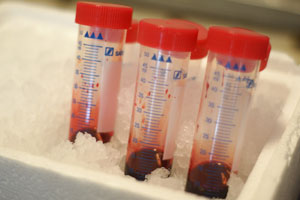The system works - over 85 million units of donated blood are given to people worldwide for use in hospitals - but there are worries about its use in routine operations, and the number of potential and active blood donors decreasing worldwide.
In the future, a long-lasting blood substitute that can be stored at room temperature and useful for all patients regardless of blood type will be on the scene - but it has been a long road so far. The quest to create artificial blood is big business, with the past 25 years seeing billions of dollars invested globally on research into a usable alternative. Many major US companies have failed to create a substitute. The American FDA is the gold standard for product approval and though some artificial blood products are licensed for use in South Africa and Russia, none have been approved in the United States or the UK.
Given that challenging landscape, scientists at the University of Essex are hoping to make progress with their Haem02 project: a one-size-fits-all, third generation artificial blood substitute. Led by Professor Chris Cooper, the research team are developing an artificial blood substitute that is a safe, long-lasting, virus-free alternative to current blood transfusions available to all countries and immediately accessible at the site of natural disasters.

Credit: University of Essex
Hemoglobin is the key protein in red blood cells that carries oxygen around our bodies. The Haem02 team aim to create an artificial hemoglobin-based oxygen carrier (HBOC) that could be used as a substitute for blood lost in surgery or trauma.
However, attempts so far to make a safe and effective HBOC have proved problematic as outside the protective environment of the red cell, hemoglobin can be toxic. The beauty of the product being engineered at Essex is that it is detoxified by the body’s own defenses.
As Cooper, a biochemist and blood substitute expert, explained, the implications of manufacturing a product with a shelf life of up to two years are huge. “It means we could overcome some of the inherent problems with transfusions as there would be no need for blood group typing and a longer shelf life means you are able to stockpile the supplies necessary for major disasters. It also offers the opportunity for routine transfusion support in ambulances or at remote inaccessible locations.”
Their engineered hemoglobin product has already been granted patents in the US and Australia and has a patent pending in the EU. They have received £1.5 million of funding from the Medical Research Council (MRC)’s Biomedical Catalyst funding programme and the Biotechnology and Biological Sciences Research Council (BBSRC)’s Super Follow On Fund.
“This is an exciting time for artificial blood research in Britain,” explained Cooper. “This funding allows our team to take to first step on the road to bridging the gap between top class research and the commercialization of a product.”





Comments